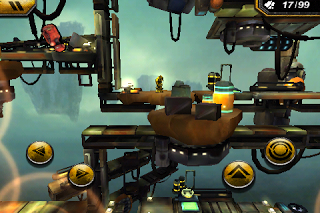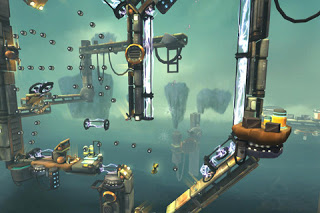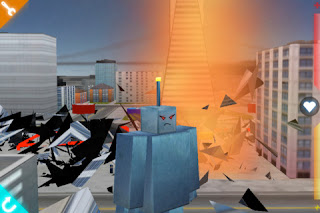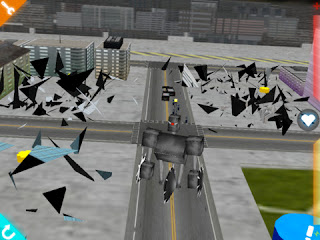Squids goes Universal, Crimson: Steam Pirates goes FREE, and more!
![]() Tunnel racers are fairly popular on the iDevice. The utilization of tilt controls, along with pretty simple gameplay appeals to casual and hardcore gamers alike. The most recent addition to this genre is Gripati Digital Entertainment’s Corridor Fly.
Tunnel racers are fairly popular on the iDevice. The utilization of tilt controls, along with pretty simple gameplay appeals to casual and hardcore gamers alike. The most recent addition to this genre is Gripati Digital Entertainment’s Corridor Fly.
 The game does take a little bit of getting use to. You’re able to fly all around the tunnel you’ll be racing through by using the iDevice’s accelerometer controls, along with a button on the bottom left to tilt your aircraft sideways, and a button on the bottom right to use whatever power-up you might have stored. This wouldn’t normally be too hard to get acclimated to, but Corridor Fly’s collision detection seems to be more than just a tad off, and with the doors closing in on you as you try and make it through them. But usually, you’ll end up crashing without touching anything. It’s the worst when you’re basically right in the center of the tunnel, and the doors are just starting to move towards you from the sides, and your ship blows up with just the edges of the doors showing. This is even more upsetting because the trailer doesn’t really show the collision detection as being this bad.
The game does take a little bit of getting use to. You’re able to fly all around the tunnel you’ll be racing through by using the iDevice’s accelerometer controls, along with a button on the bottom left to tilt your aircraft sideways, and a button on the bottom right to use whatever power-up you might have stored. This wouldn’t normally be too hard to get acclimated to, but Corridor Fly’s collision detection seems to be more than just a tad off, and with the doors closing in on you as you try and make it through them. But usually, you’ll end up crashing without touching anything. It’s the worst when you’re basically right in the center of the tunnel, and the doors are just starting to move towards you from the sides, and your ship blows up with just the edges of the doors showing. This is even more upsetting because the trailer doesn’t really show the collision detection as being this bad. All of this seems really bad, and it kind of is. With the amount of really good tunnel racers out there, it’s hard to recommend Corridor Fly. All of these issues could be fixed in an update, and hopefully they all will, but it’s not looking promising, with no iTunes reviews, and only 34 GameCenter scores, it doesn’t look like sales will be pushing a quick update to be submitted, if at all, but if one does come, you know that we’ll keep you informed of it.
All of this seems really bad, and it kind of is. With the amount of really good tunnel racers out there, it’s hard to recommend Corridor Fly. All of these issues could be fixed in an update, and hopefully they all will, but it’s not looking promising, with no iTunes reviews, and only 34 GameCenter scores, it doesn’t look like sales will be pushing a quick update to be submitted, if at all, but if one does come, you know that we’ll keep you informed of it.
![]() Anti-gravity platformer games are really un-explored territory when it comes to iOS games. Actually, I can’t really think of one title that has taken complete advantage of gravity mechanics. Until now. Inertia: Escape Velocity, developed by Red Fly Studio, could very well be the first iOS platformer game to seriously manipulate gravity, using the mechanics as the core of the game, and they pull it off perfectly. I guess it should be brought up that Red Fly Studio has built Inertia: Escape Velocity expanding on award-winning gameplay that won Best Non-Professional Game, Achievement in Gameplay, Technical Achievement, and Gamers’ Choice Awards at DICE’s Indie Game Challenge this year (2011).
Anti-gravity platformer games are really un-explored territory when it comes to iOS games. Actually, I can’t really think of one title that has taken complete advantage of gravity mechanics. Until now. Inertia: Escape Velocity, developed by Red Fly Studio, could very well be the first iOS platformer game to seriously manipulate gravity, using the mechanics as the core of the game, and they pull it off perfectly. I guess it should be brought up that Red Fly Studio has built Inertia: Escape Velocity expanding on award-winning gameplay that won Best Non-Professional Game, Achievement in Gameplay, Technical Achievement, and Gamers’ Choice Awards at DICE’s Indie Game Challenge this year (2011).
 You’ll guide a robot who has crash landed on a distant planet through 35 levels, collecting items that you can use to put your ship back together. The fun part? You can manipulate gravity, and use a ton of interesting objects to get you through hazards and around difficult corners of the levels.
You’ll guide a robot who has crash landed on a distant planet through 35 levels, collecting items that you can use to put your ship back together. The fun part? You can manipulate gravity, and use a ton of interesting objects to get you through hazards and around difficult corners of the levels.  Inertia: Escape Velocity is, to say the least, a huge game. The 35 levels all have 3 badges for you to earn, one for completion, one for picking up all of the bolts in the level, and another for finishing the level in a certain amount of time. Getting each one of these will require multiple playthroughs. Once you beat all 35 of the original stages, if you want more, you can purchase another 24 levels, each called the Inferno levels, which are the original levels, but set up like challenge levels, with increased difficulty, and different objects to use, more hazards, and a certain amount of big red bolts to collect so that you can open up the Mastery Levels, which are 5 of the hardest levels in the game, each also having the 3 badges to try and snag, all for $0.99. The original game is $1.99, so for all of the levels it’ll be $2.99. But if you decide not to buy the extra levels, the original 35+ levels will give you quite a bit of gameplay, taking about 4 hours to complete, not counting all the hours you can sink into them going back trying to grab all of the items and beating the level times. For the price, Inertia: Escape Velocity is an amazing game, and a definite must buy. It’s very quickly moved up to the #4 spot on my top 5 games of the year, making it incredibly easy to recommend to any and all platform and puzzle lovers.
Inertia: Escape Velocity is, to say the least, a huge game. The 35 levels all have 3 badges for you to earn, one for completion, one for picking up all of the bolts in the level, and another for finishing the level in a certain amount of time. Getting each one of these will require multiple playthroughs. Once you beat all 35 of the original stages, if you want more, you can purchase another 24 levels, each called the Inferno levels, which are the original levels, but set up like challenge levels, with increased difficulty, and different objects to use, more hazards, and a certain amount of big red bolts to collect so that you can open up the Mastery Levels, which are 5 of the hardest levels in the game, each also having the 3 badges to try and snag, all for $0.99. The original game is $1.99, so for all of the levels it’ll be $2.99. But if you decide not to buy the extra levels, the original 35+ levels will give you quite a bit of gameplay, taking about 4 hours to complete, not counting all the hours you can sink into them going back trying to grab all of the items and beating the level times. For the price, Inertia: Escape Velocity is an amazing game, and a definite must buy. It’s very quickly moved up to the #4 spot on my top 5 games of the year, making it incredibly easy to recommend to any and all platform and puzzle lovers. 
![]() Full on destruction games are kind of a niche genre within the AppStore, there’s really only a couple of titles that I can think of using destruction as a core mechanic, Destructopus, Robot Rampage, and to a lesser extent, Blast Zone Mega, and Burn The City, which is really more in the line of an Angry Birds type physics puzzler, but you get the idea. It’s not a genre that’s been well expanded on. Andrew Wang, and Ayopa Games (W.E.L.D.E.R., Chicken Rescue) are giving us one more title to add to that very short list. Inspired by the classic arcade game, Rampage, and taking influences from The Simpsons and Futurama, as well as trying to incorporate the customization of Mechwarrior, BigBot Smash is now available for our iDevices, and fingertips that are hungry for destruction.
Full on destruction games are kind of a niche genre within the AppStore, there’s really only a couple of titles that I can think of using destruction as a core mechanic, Destructopus, Robot Rampage, and to a lesser extent, Blast Zone Mega, and Burn The City, which is really more in the line of an Angry Birds type physics puzzler, but you get the idea. It’s not a genre that’s been well expanded on. Andrew Wang, and Ayopa Games (W.E.L.D.E.R., Chicken Rescue) are giving us one more title to add to that very short list. Inspired by the classic arcade game, Rampage, and taking influences from The Simpsons and Futurama, as well as trying to incorporate the customization of Mechwarrior, BigBot Smash is now available for our iDevices, and fingertips that are hungry for destruction.
 To start it off, the controls in BigBot Smash will take quite a bit of getting use to, but once you do, even more problems show their face. There are two different control schemes included in the game. The first control method uses the iDevice’s accelerometer, tilting to turn the world that you’ll be destroying. This can be extremely difficult to use, as you’ll need to turn your device completely around to turn your robot around, and tilt it in pretty uncomfortable ways to turn. Tapping on the screen controls your robots projectiles, and tapping on the robot will make it jump. If you tap on a building that is close to the robot, it will smash it with it’s fists. Here’s where it gets even more difficult. If the building is just a little bit too far away, you’ll shoot at it instead of smashing it, which takes up quite a bit of time, which can be pretty frustrating in the Speedrun Mode, but outside of the Speedrun Mode, it’s just bothersome. Tapping on your robot also does not always make it jump, sometimes it will jump, and other times it will destroy the building right in front of it. There are touch controls as well, which have the same sort of issues as the tilt controls, except you won’t be tilting your device in uncomfortable ways, instead, you’ll be dragging your finger on the screen to change the robot’s direction. However, this also has it’s own issues, as more than half of the time, dragging your finger across the screen is registered as a tap, and will result in the robot shooting it’s projectiles. It’s not so bad that you won’t be able to play the game, but once you hit stage 4 in the campaign mode, and the game gets a little more hectic, you’ll be constantly wanting to turn the game off out of frustration. The same goes for the speed demolition and survival challenge modes, once the game reaches that point where the action picks up, the controls become a real issue.
To start it off, the controls in BigBot Smash will take quite a bit of getting use to, but once you do, even more problems show their face. There are two different control schemes included in the game. The first control method uses the iDevice’s accelerometer, tilting to turn the world that you’ll be destroying. This can be extremely difficult to use, as you’ll need to turn your device completely around to turn your robot around, and tilt it in pretty uncomfortable ways to turn. Tapping on the screen controls your robots projectiles, and tapping on the robot will make it jump. If you tap on a building that is close to the robot, it will smash it with it’s fists. Here’s where it gets even more difficult. If the building is just a little bit too far away, you’ll shoot at it instead of smashing it, which takes up quite a bit of time, which can be pretty frustrating in the Speedrun Mode, but outside of the Speedrun Mode, it’s just bothersome. Tapping on your robot also does not always make it jump, sometimes it will jump, and other times it will destroy the building right in front of it. There are touch controls as well, which have the same sort of issues as the tilt controls, except you won’t be tilting your device in uncomfortable ways, instead, you’ll be dragging your finger on the screen to change the robot’s direction. However, this also has it’s own issues, as more than half of the time, dragging your finger across the screen is registered as a tap, and will result in the robot shooting it’s projectiles. It’s not so bad that you won’t be able to play the game, but once you hit stage 4 in the campaign mode, and the game gets a little more hectic, you’ll be constantly wanting to turn the game off out of frustration. The same goes for the speed demolition and survival challenge modes, once the game reaches that point where the action picks up, the controls become a real issue.  For $0.99, it’s not a bad game by any means. The controls can be worked with, and might actually just have so many issues if you’re playing on a small screen. Gameplay videos on the iPad show the game in a completely different light, and since the game is Universal, you won’t need to buy an HD version to find out. There are GameCenter leader boards, though only for Survival and Speed modes, but do have 48 achievements to try and grab. There is quite a bit of replay value, and the core gameplay looks like it could be great fun. But until an update hits with some tighter controls, it’s hard to really give the game a fair play on my small screen, but I’m excited about having the opportunity to.
For $0.99, it’s not a bad game by any means. The controls can be worked with, and might actually just have so many issues if you’re playing on a small screen. Gameplay videos on the iPad show the game in a completely different light, and since the game is Universal, you won’t need to buy an HD version to find out. There are GameCenter leader boards, though only for Survival and Speed modes, but do have 48 achievements to try and grab. There is quite a bit of replay value, and the core gameplay looks like it could be great fun. But until an update hits with some tighter controls, it’s hard to really give the game a fair play on my small screen, but I’m excited about having the opportunity to.